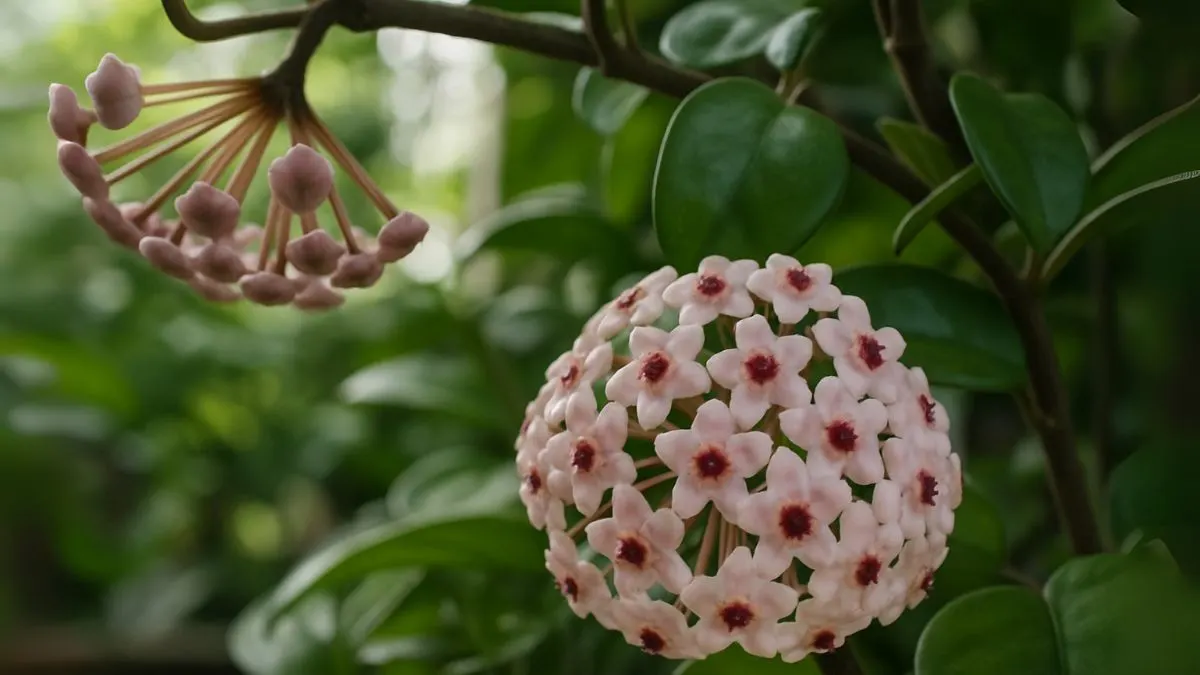Have you ever seen a plant that looks too perfect to be real? That’s the magic of Hoyas. With their waxy, porcelain-like flower clusters, they seem hand-sculpted, as though crafted from glass or ceramic. It’s no wonder they’re often called porcelain flowers or wax plants.
The Hoya carnosa, in particular, has earned global admiration. From homes in Canada to apartments in New York, this plant adds a timeless, tropical vibe. In my own plant journey, I bought my first Hoya Carnosa online, and I was surprised at how healthy and of good quality it was. Within months, it rewarded me with its first bloom—an unforgettable moment.
What Makes Hoyas Special?

- Hoyas feature waxy, porcelain-like flower clusters that often release a sweet fragrance at night.
- They are commonly known as hoya, porcelain flower or wax plant, making them easy to identify across cultures.
- Their trailing vines make them versatile—perfect for hanging baskets, tabletops, or climbing trellises.
- Unlike many ornamental flowers, Hoya flower nectar is non-toxic, making them pet-friendly.
Hoya Carnosa – The Star of the Show
- Hoya carnosa, the porcelain flower or wax plant, is one of the most famous and beginner-friendly species.
- It grows as a climbing or trailing vine, producing thick, waxy leaves and delicate star-shaped blooms.
- Many customers find the Hoya Carnosa plant healthy and of good quality, which is why it’s a bestseller in plant nurseries and online shops.
Also Read: 15 Resilient Annuals That Love a September Start
Why Hoya Carnosa Stands Out
- Easy to care for with minimal watering needs.
- Blooms regularly when mature.
- Can thrive in pots, hanging baskets, or mounted as a climber.
Caring for Your Hoya Plant
1. Light Requirements
- Hoyas thrive in bright, indirect light, but some varieties can adapt to partial shade.
- Avoid harsh afternoon sun that can scorch their leaves.
2. Watering Needs
- Water moderately—allow the soil to dry slightly between waterings.
- Overwatering is the number one mistake; well-draining soil is crucial.
3. Soil & Fertilizer
- Use a chunky, well-draining mix like orchid bark and perlite.
- Fertilize monthly in spring and summer to encourage blooms.
4. Temperature & Humidity
- Ideal growing range: 65–85°F (18–29°C).
- They love humidity, so mist occasionally or use a humidifier in dry regions.
Also Read: The Secret to Blooming Big, Bold Dahlias in Your Backyard
Famous Hoya Varieties You’ll Love
-
Hoya Carnosa
The classic and most widely grown. Its clusters of pale pink flowers make it an all-time favorite.
-
Hoya Compacta (Hindu Rope Plant)
Known for its curly, rope-like leaves, this variety makes an eye-catching hanging plant.
-
Hoya Kerrii (Sweetheart Plant)
With heart-shaped leaves, this one is often gifted as a symbol of love.
-
Hoya Australis
A strong climber that produces white, fragrant blooms and glossy green leaves.
-
Hoya Obovata
Loved for its large, round leaves with speckled patterns—unique and striking.
Why Hoyas Are Loved Worldwide 🌍
- In Canada, they’re a favorite for brightening long winters indoors.
- In the USA, hoyas are trendy houseplants for apartments and small spaces.
- In Europe, their exotic charm and low-maintenance nature have made them sought-after additions to homes and offices.
Their versatility, paired with their porcelain-like flowers, makes them a universal favorite.
Also Read: Your Step-by-Step Guide to Growing Crossandra
Quick Hoya Care Guide
Care Aspect |
Recommendation |
Light |
Bright, indirect light |
Watering |
Moderate; let soil dry slightly |
Soil |
Well-draining, chunky mix |
Temperature |
65–85°F (18–29°C) |
Humidity |
Moderate to high |
Fertilizer |
Monthly during growing season |
Personal Experience – Why I Fell in Love with Hoya
When I first saw a Hoya Carnosa, I didn’t believe the flowers were real. Their waxy shine made them look artificial. Once I brought mine home, I noticed how it added a tropical, calming energy to my living space.
The day it bloomed, I realized why gardeners around the world treasure it. The sweet fragrance and delicate star-shaped flowers were like a little piece of paradise indoors. Since then, I’ve added Hoya Compacta and Hoya Kerrii to my collection, and they’ve become my most complimented plants.
Conclusion
If you’re looking for a houseplant that’s both easy to care for and visually stunning, the Hoya, or porcelain flower/wax plant, is the perfect choice. From the beloved Hoya Carnosa to unique varieties like Hoya Kerrii, these plants are admired for their waxy, porcelain-like flower clusters and low-maintenance needs.
And the best part? Hoya flower nectar is non-toxic, making them safe in homes with pets or kids.
🌸 Your next step? Say hola to Hoyas by adding one to your collection—you’ll quickly understand why they’re adored worldwide.






